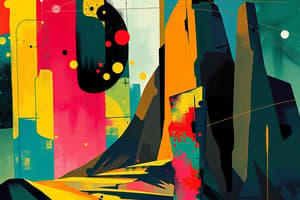Podcast
Questions and Answers
Which art style is derived from the name associated with geometric shapes?
Which art style is derived from the name associated with geometric shapes?
- Cubism (correct)
- Nonobjectivism
- Mechanical Style
- Futurism
What characterizes nonobjectivism in art?
What characterizes nonobjectivism in art?
- Utilizes recognizable subjects and forms
- Focuses on historical events
- Avoids any representation of figures (correct)
- Features a dynamic interpretation of nature
Which artist is associated with the creation of works that highlight existence in the industrial age?
Which artist is associated with the creation of works that highlight existence in the industrial age?
- Fernand Léger (correct)
- Georges Braque
- Wassily Kandinsky
- Pablo Picasso
What is the goal of futurism in art as described?
What is the goal of futurism in art as described?
Which element of abstractionism focuses on analyzing and simplifying forms?
Which element of abstractionism focuses on analyzing and simplifying forms?
What distinguishes pure abstractionism from representational abstractionism?
What distinguishes pure abstractionism from representational abstractionism?
Which of the following art movements is NOT classified under abstractionism?
Which of the following art movements is NOT classified under abstractionism?
Which artist is associated with the art movement that reflects a fast-paced, machine-powered age?
Which artist is associated with the art movement that reflects a fast-paced, machine-powered age?
What is a characteristic feature of the Mechanical Style in abstractionism?
What is a characteristic feature of the Mechanical Style in abstractionism?
Flashcards are hidden until you start studying
Study Notes
Abstractionism Overview
- Defined by logical and rational processes: analyzing, detaching, selecting, and simplifying.
- Key artworks include Le Violon (Oval Still Life) by Georges Braque, which exemplifies representational abstractionism from 1914.
- Composition IV by Wassily Kandinsky represents pure abstractionism from 1911, with no recognizable subject matter.
Art Styles Under Abstractionism
- Key styles include Cubism, Futurism, Mechanical Style, and Nonobjectivism.
Cubism
- Originates from the term "cube," emphasizing geometric forms.
- Notable artist: Pablo Picasso (1881-1973), a Spanish painter and sculptor known for pivotal contributions to modern art.
Futurism
- Emerged in Italy in the early 1900s, embracing themes of speed and technology.
- Focused on depicting a machine-accelerated contemporary life.
- Prominent figure: Gino Severini (1883-1966), an Italian painter associated with Futurism.
Mechanical Style
- Characterized by the precise and neat arrangement of basic forms in art.
- Significant artist: Fernand Léger (1881-1955), recognized as a visionary of modern art, whose works deeply engage with themes of existence in the industrial age.
Nonobjectivism
- Marked by the absence of figures or recognizable forms, creating a purity in abstraction.
- Artworks have no references to objects or forms found in the natural world.
- Influential artist: Piet Mondrian (1872-1944), a Dutch painter known for his nonobjectivist style.
Abstractionism Overview
- Defined by logical and rational processes: analyzing, detaching, selecting, and simplifying.
- Key artworks include Le Violon (Oval Still Life) by Georges Braque, which exemplifies representational abstractionism from 1914.
- Composition IV by Wassily Kandinsky represents pure abstractionism from 1911, with no recognizable subject matter.
Art Styles Under Abstractionism
- Key styles include Cubism, Futurism, Mechanical Style, and Nonobjectivism.
Cubism
- Originates from the term "cube," emphasizing geometric forms.
- Notable artist: Pablo Picasso (1881-1973), a Spanish painter and sculptor known for pivotal contributions to modern art.
Futurism
- Emerged in Italy in the early 1900s, embracing themes of speed and technology.
- Focused on depicting a machine-accelerated contemporary life.
- Prominent figure: Gino Severini (1883-1966), an Italian painter associated with Futurism.
Mechanical Style
- Characterized by the precise and neat arrangement of basic forms in art.
- Significant artist: Fernand Léger (1881-1955), recognized as a visionary of modern art, whose works deeply engage with themes of existence in the industrial age.
Nonobjectivism
- Marked by the absence of figures or recognizable forms, creating a purity in abstraction.
- Artworks have no references to objects or forms found in the natural world.
- Influential artist: Piet Mondrian (1872-1944), a Dutch painter known for his nonobjectivist style.
Studying That Suits You
Use AI to generate personalized quizzes and flashcards to suit your learning preferences.




